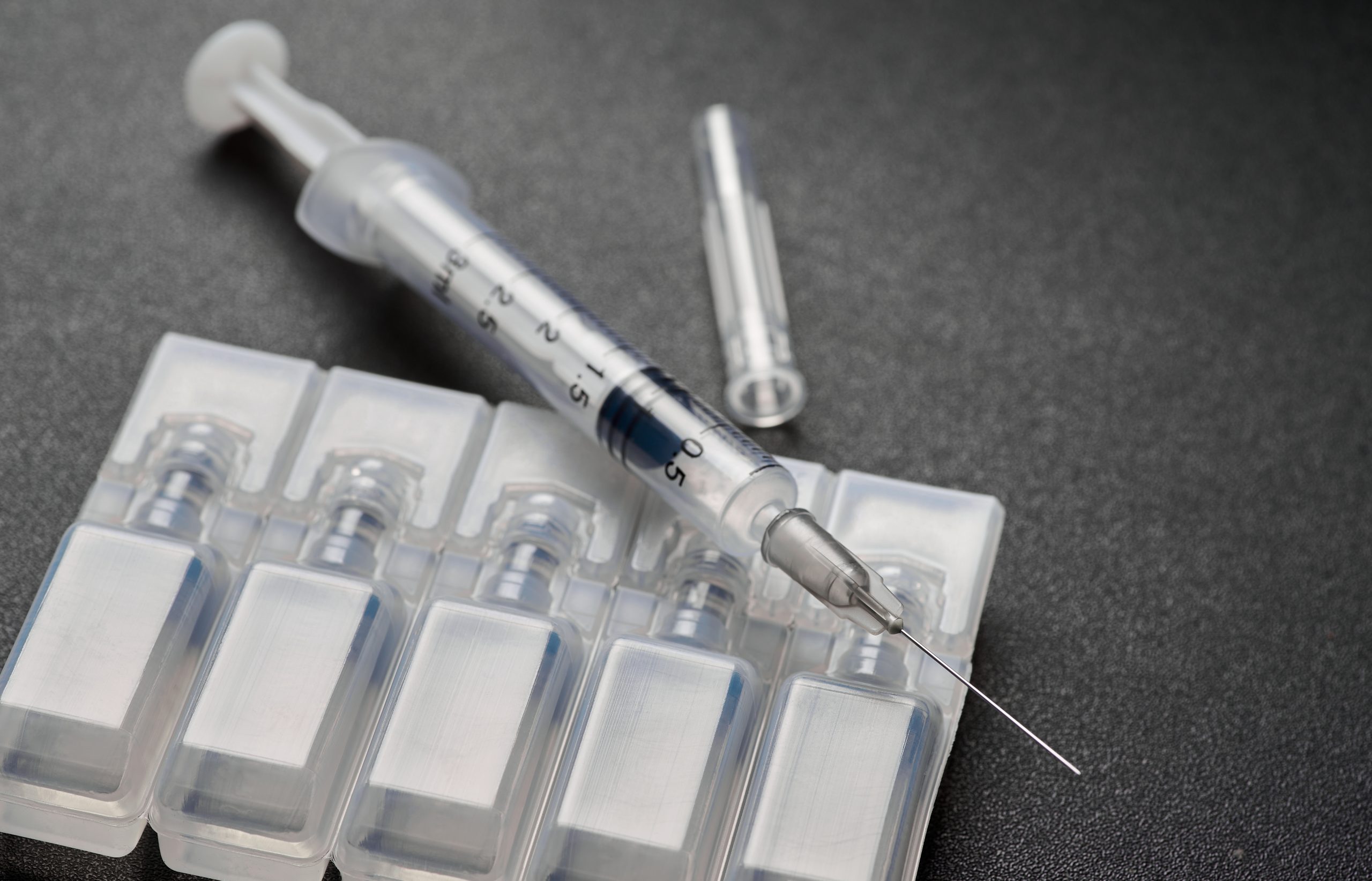According to Mao et al. (2022), intra-articular hyaluronic acid (HA) injections have been identified as a beneficial treatment for improving the range of motion (ROM) in the shoulder of patients with frozen shoulder (FS). The study concludes that HA injections demonstrate equal effectiveness in delivering superior pain relief.
Intra-articular hyaluronic acid (HA) injections can aid patients seeking non-surgical treatment options to enhance shoulder mobility. While frozen shoulder (FS) is one of the various self-limiting conditions, HA injections, like Orthovisc, can provide significant functional improvements without higher risks of adverse events that surgical interventions can cause.
This article will explore Orthovisc injections for the shoulder, their mechanism of action, safety, and efficacy of this injection treatment.
Key Takeaways
- Orthovisc supplements the lost HA when injected into the joint, acting as a lubricant and shock absorber.
- Shoulder OA is a chronic and exhausting joint disease that can limit the range of motion and impact daily activities.
- An Orthovisc shoulder osteoarthritis study revealed that Orthovisc’s 8 mL single injection was superior to the control group in pain reduction at six months.
- Specific patient testimonials for Orthovisc shoulder injections are not readily available, but limited clinical trials have reported significant improvements in patients’ joint function and pain reduction.
- Healthcare providers must directly administer Orthovisc into the affected joint, and following general safety practices can ensure a safe and effective procedure.
About: Medica Depot is your trusted all-in-one supplier, offering a range of high-quality medical injectables and supplies. If you’re looking to buy Orthovisc wholesale, you can do so on Medica Depot quickly and easily. We offer a worry-free experience in searching for the best and most popular products on the market. Whether for health professionals, plastic surgeons, dermatologists, licensed estheticians, or other specialists, we can offer genuine, brand-name products you may need. With Medica Depot, we prioritize serving you better to improve the patient’s quality of life.
Introduction to Orthovisc Injections for Shoulder Osteoarthritis

Osteoarthritis (OA) is a degenerative joint disease that often affects joints, including the knees, shoulders, hips, and spine. Orthovisc is a non-surgical treatment option for osteoarthritis (OA), specifically in the knee. Healthcare providers directly administer this therapy to the affected joint and use it when other first-line treatments are ineffective.
Orthovisc’s formulation mimics the hyaluronic acid (HA) found in the joint’s synovial fluid, which surrounds the joint. Orthovisc supplements the lost HA when injected into the joint, acting as a lubricant and shock absorber. They aim to restore the cushioning and lubricating properties of the joint fluid, providing relief from pain caused by OA.
Shoulder OA is a chronic and exhausting joint disease that can limit the range of motion and impact daily activities. This occurs when the cartilage inside the shoulder joint wears down, causing the bones to rub together. This OA condition can cause joint pain, stiffness, and weakness in the shoulder.
Mechanism of Action of Orthovisc Injections
When injected intra-articularly, Orthovisc is a high molecular weight that supplements joint cushioning to temporarily provide pain relief caused by osteoarthritis (OA). Similar to Orthovisc vs Hyalgan or other viscosupplements, they work by renewing the efficient lubrication and cushioning absent from the joint’s synovial fluid.
It restores the essential properties of synovial fluid, lubricates, cushions, and protects the joint, bringing significant relief and improved quality of life. It’s worth noting that Orthovisc is one of many treatments for OA, particularly in the knee. While it has no indications for the shoulder joint, some medical professionals may use it as an off-label solution.
Compared to other treatment options, healthcare providers may suggest Orthovisc when first-line therapies have not affected individuals. Moreover, severe cases may require surgical intervention. OA patients should consult their trusted doctors to understand the benefits, potential risks, and side effects and know if it’s the most suitable choice for their needs and conditions.
Clinical Efficacy of Orthovisc Injections for Shoulder Osteoarthritis

While limited resources are available online, a clinical study evaluated the safety and effectiveness of Orthovisc shoulder injection compared to corticosteroid injection. This Orthovisc shoulder osteoarthritis study revealed that Orthovisc’s 8 mL single injection was superior to the control group in pain reduction at six months.
In addressing the American Shoulder and Elbow Surgeons Evaluation Form, both treatments (Orthovisc and control) shared similar effects from baseline to six months in patients’ shoulder osteoarthritis. However, patients must know that the US Food and Drug Administration has approved Orthovisc only for knee OA.
Orthovisc may significantly improve the quality of life of individuals with knee OA, but we must discuss its safety and efficacy in addressing shoulder OA concerns. Medical professionals can answer questions about the benefits of Orthovisc shoulder injections and potential risks and complications as an off-label option.
Based on Orthovisc’s advantages for knee OA, it may also offer similar significant improvements in patient’s quality of life after treatment. By reducing pain and improving joint function, Orthovisc can deliver a better range of motion in the shoulder joint and allow patients to return to their daily activities.
Real-World Applications and Experiences with Orthovisc Injections
Specific patient testimonials for Orthovisc shoulder injections are not readily available, but limited clinical trials have reported significant improvements in patients’ joint function and pain reduction. Orthovisc for shoulder osteoarthritis (OA) may need further research and clinical trials to prove its safety and efficacy in treating this degenerative joint disease in the shoulders.
Another clinical trial about hyaluronic acid injections as solutions for shoulder OA revealed that non-animal stabilized hyaluronic acid (NASHA) can affect for over six months and is well-tolerated in patients with symptomatic shoulder OA.
For patients seeking a non-surgical option for their shoulder OA symptoms, Orthovisc or other viscosupplements can address their concerns. Healthcare providers can provide comprehensive information about possible treatment, what patients can expect, and whether they are suitable candidates.
Best Practices for Administering Orthovisc Shoulder Injections

As an off-label solution, patients need to seek medical professionals’ guidance throughout the treatment. Healthcare providers must directly administer Orthovisc into the affected joint, and following general safety practices can ensure a safe and effective procedure.
- Dosage: The usual Orthovisc dosage for the knee is 2 mL, and medical professionals may apply a similar dosage regimen to the shoulder. Completing a cycle requires three to four injections administered weekly.
- Administration Techniques: A medical professional must know the appropriate administration technique for Orthovisc injections. Their expertise in injecting these solutions can maximize the benefits of Orthovisc.
- Injection Site Considerations: Providers must remove joint effusion in the injection site before administration. Moreover, they should adequately clean and disinfect that area before injection to avoid complications.
Like other medications, patients can expect potential side effects after Orthovisc injections. These symptoms may subside over time once the body adapts to the medicine. If these persist, seek medical attention, and providers can help individuals manage them effectively.
- Pain
- Swelling
- Heat
- Rash
- Itching
- Bruising
- Redness
Conclusion
Orthovisc injections offer a promising treatment option for patients with shoulder osteoarthritis (OA). While further studies and research are required, Orthovisc shoulder injections may work similarly to knee applications, supplementing the synovial fluid and enabling lubrication and shock absorption for the joints.
Limited clinical trials may show its efficacy; however, it’s worth noting that Orthovisc is currently US FDA-approved only for knee OA. While some may recommend it as an off-label solution for shoulder OA, patients must discuss the benefits and potential risks of Orthovisc shoulder injections with a healthcare provider.
FAQs
1. What is Orthovisc shoulder injection used for?
While Orthovisc is approved solely for the knee, medical professionals may use Orthovisc shoulder injections as off-label solutions to treat shoulder pain and discomfort caused by osteoarthritis.
2. How effective are Orthovisc shoulder injections?
According to a clinical trial, Orthovisc shoulder injections have effectively reduced pain and improved function in patients with shoulder osteoarthritis compared to a corticosteroid control group.
3. Are there any side effects of Orthovisc shoulder injections?
Like any medical procedure, Orthovisc shoulder injections may have side effects. These may include pain, swelling, bruising, and stiffness at the injection site. It is essential to discuss any concerns with your healthcare provider before undergoing this treatment.
References
- Mao, B., Peng, R., Zhang, Z., Zhang, K., Li, J., & Fu, W. (2022). The Effect of Intra-articular Injection of Hyaluronic Acid in Frozen Shoulder: a Systematic Review and Meta-analysis of Randomized Controlled Trials. Journal of orthopaedic surgery and research, 17(1), 128. https://doi.org/10.1186/s13018-022-03017-4
- McKee, M. D., Litchfield, R., Hall, J. A., Wester, T., Jones, J., & Harrison, A. J. (2019). NASHA hyaluronic acid for the treatment of shoulder osteoarthritis: a prospective, single-arm clinical trial. Medical devices (Auckland, N.Z.), 12, 227–234. https://doi.org/10.2147/MDER.S189522









